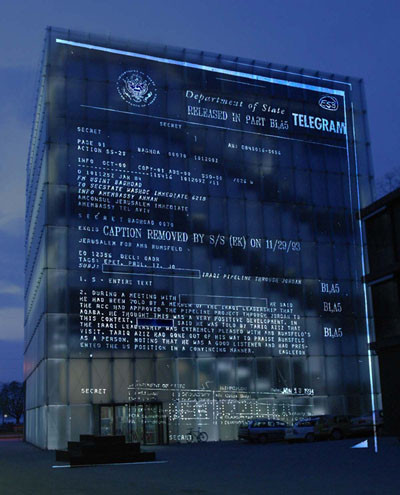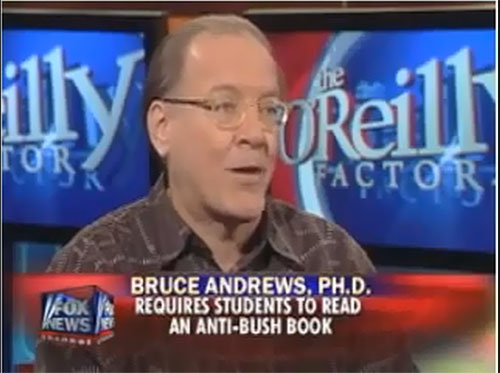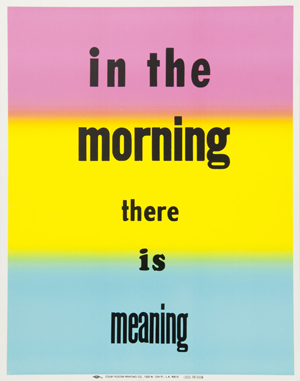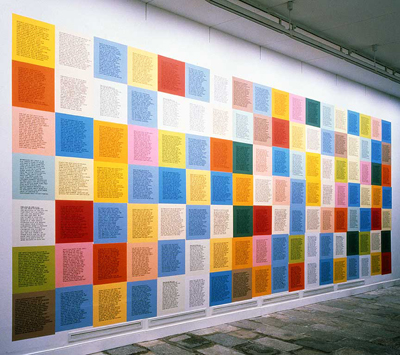Witness Jenny Holzer (with special reference to Bruce Andrews and Eve Fowler)
Idiolect of know-how

No one’s a kid for twenty years without a little know-how. I was a child in the 80s and child of the 90s because I kept up with kid stuff instead of going to college. I went to school on post punk music, the Walker Art Center, and the language poetry I read in my local public library. So I know to be true that the following—my opening gambit—is well after the fact. That’s true, but it’s just a caveat. I get the feeling my indefinite childhood is increasingly passé. All grown up now, I still feel accountable to my schooling. I work in a school, and often enough in its library. Was 80s postmodernism always narrowly scholastic? Or is that, judging from the bizarre resistance to it I encounter teaching MFA students, only now the consensus, a truism it takes extra work to outreach? There’s even a confusion of identity politics with political correctness, an eclipsing of the political by politics that, to my mind, began to take its present form at the outset of Reagan-era “culture wars.”
Late in the Q & A transcribed in Bruce Andrews’ contribution to The Politics of Poetic Form is a striking reference to Jenny Holzer’s Truisms project, and its 1982 rendering as “Messages to the Public,” wherein her famous quips-cum-axioms shone out of a giant spectacolor sign in New York’s Times Square. E.g. “PRIVATE PROPERTY CREATED CRIME.” Andrews is talking about efficacy.
I don’t think it’s just that literary misbehavior is shunted aside, as a little bauble that’s not going to bother anybody; it’s also whole ranges of theoretical discourse trying to come to grips with history, the world system, the nature of America’s political economy, etc. etc. that equally don’t have the ability, like those excruciating banalities of Jenny Holzer, to get up on Times Square and broadcast to thousands of people. It’s not just poetry that suffers from that kind of marginalization. But there may be a curious parallel between…activities that carry, in themselves…that reach, and the ones that are specifically denied that kind of reach…
It bugs me because the question of efficacy is relevant despite “the reach.” At first I wouldn’t have said so. I’d have wondered: Holzer’s is which kind of activity, exactly? But it’s neither “specifically denied that kind of reach” nor does it “carry…that reach” in itself. Its platform is not the half of it. Flamboyance is the new mediocrity, and the 80s are the new old, in this sense at least. Andrews is talking about a crisis of categories, but for a moment relapses into evaluative categorization. What bugs him exactly, its reach or its banality? Maybe the latter follows from the former? As Brent Cunningham suggests, I think rightly, this may be a true question falsely stated.
Truism is not truth. The verbal structure and iconic venue (format and platform) both reference platitudes to great effect; T-shirts, baseball caps, tacky fliers: the Truisms speak a jargon of public relations too late for any nostalgia for the heroic tradition of the affiche. They reach the unsuspecting the way punch lines mustn’t be inferred but you need to feel you “get” the joke. Epigrammatic and mesmerizing suppositions coagulate to the point of facticity. Meanwhile, we fallible creatures speak an idiolect of know-how: mere jargon. That “curious parallel” between double standards is “excruciating” indeed.
It seems like a truism now to say that vanguard art and poetry of the 80s resurrected “social materials” whence they had been relegated to some place magically extra-verbal. Andrews’ I Don’t Have Any Paper So Shut Up (Or, Social Romanticism) is vivid testimony of this—and among my favorite books, ever. But Hozler’s tactics pose the question, surely a rhetorical one: Who needs paper? Before I’d been informed of our post-medium condition, I had had that thoroughly congruous experience of sitting on a bench inscribed with Holzer’s language. The media: LED signs, concrete benches, massive architectural edifices rendered screens, tattoos, condoms, inked or lit up say at once, “You’d better sit down for this,” or, “By the way…” or “Peek-a-boo!”
What does social romanticism mean these thirty years later? Housing flustered discourse overheard by Web 2.0, or by any analogue era urban sociolectician, in a book, a literarily “specific object”? Holzer’s social materials undergo a rather more bluntly realist treatment than that. Insofar as they are gathered into an art object, they are also inscribed there, as though they were written elsewhere—which indeed, they were. They are almost never encountered as literature, and so she throws a voice. But one could never really speak of “voice” the way one can when speaking of poetry, whose objective status, its ontological whereabouts, is never certain, no matter how particular its visual prosody. The atomized or isolable speaker is cracked, multiplied or flayed in an Andrews poem. And though like Andrews’ work insofar as serial form prevails, his sense of sociolect differs from Holzer’s sense of idiolect. The latter is composted by platform as a well as format.
Social romanticism means you, too. The reader works two ways to satisfy the medium: 1) participating by being read, anyone could have said what everyone now knows; 2) participating by reading, grafting in the mind’s eye connective tissue to the fragments spliced in the space of a line to which one sense but not both could belong. E.g. Andrews: “The letter bombs are decorative[.]” Taking a survey for compensation: market research. The truth is beyond reach, and that’s the last fact you can grasp. Fugitive, tantalizing, emancipating us from the exhaustive faith it once demanded. This I now see as a very 80s postmodernism, one that underscores the Euroethnic and specifically Cartesian tenet that while truth is universal, it is only personally verifiable. The cogito, the universal man, underwrites imperialist, racist, ableist attempts to disappear alterity. You need only recognize what you are shown to earn membership. Literature had been the concern of making heard what you say, but not anymore. Truisms pin truths to the surface of things; Truth as depth structure cedes to truths at face value. The statements are banal enough to fit, and wrought that way.
Holzer’s later work proposes that truth does exist, as replication if not in reply. Truth Before Power is the name of the series, and its use of declassified documents in of themselves marks an abrupt tactical change. Instead of an author, she is a researcher combing the National Security Archives. But truth is not ascertainable, rather merely asserted. The Xenon projections are crucial—filtering and reflection are processes through which “truth” is, like a score, conducted. Alchemized into light itself, the overwhelming bluish-white beams affix themselves to even the most unhospitable surfaces (reminding us that, for readers, spatial volume obscures meaning where aural volume clarifies it). Truth Before Power’s projections broadcast clandestine communiqués. Here is what was said on your behalf, blown up out of all proportion. The projections approximate what I mean by “visual prosody because they show secret hearings. It is in the overheard statement that this occurs, and simultaneous to it: the basic objective of prosody, by any working definition of the term.

Bruce Andrews, a Political Scientist at Fordham University, appeared on The O’Reilly Factor in 2006. Bill O’Reilly’s “reach” exploits the same defunct channel between intelligence and conviction that Andrews attempts to describe, as a pedagogical objective. Of course, acknowledging there is such a channel outrages his host.
Truth cannot be declined, but power can insofar as it is resisted, dismissed, and itself resistant. Power is a force which may not act on the dynamic object called a subject. We fight power, per se. We fight the multiplicity of truths especially when it presents itself as Truth, as universal. This is the topic of an essay reproduced in the Kuntshaus Bregen’s catalog for Truth Before Power, from which the series derives its title. “Truth Before Power” appears as a concluding rubric to Sherman Kent’s “Estimates and Influence.” Kent is widely considered to have invented “intelligence analysis” during his career in the CIA and as a Yale University professor. The essay, from 1966, describes what it is, precisely, that imperils the “reach” of Truth to Power, or “intelligence” to “conviction.” For Kent, speaking to an international gathering of intelligence officials,
Influence cannot be our goal, [so] what should it be? Two things. It should be relevan[ce] within the area of our competence, and above all it should be to be credible. Let things be such that if our policymaking master is to disregard our knowledge and wisdom, he will never do so because our work was inaccurate, incomplete, or patently biased. Let him disregard us only when he must pay greater heed to someone else. And let him be uncomfortable—thoroughly uncomfortable—about his decision to heed this other.
The documents Holzer projects, even though they are censored for “sensitivity,” reveal what’s important: the “someone else” heeded by American administrations at the outset (1985 or so) of our present interventionist pursuits in Central America and the Middle East. The strike-thrus are especially effective moments, visually, because they seem to pun on the reach between intelligence and conviction, being an opacity bright enough to be seen. Lacunae lit from within are auroral. E.g. Andrews: “nobody buys arrogance / to prove an hallucination you need a witness to reality[.]”
For the most part I will leave off the comparison of Andrews to Holzer here and shift to another reference point, in Eve Fowler. Fighting the urge to look at Andrews’ Love Songs, for instance, as visual prosody, I think it is helpful to read Holzer in terms of transvaluative truths, and that transition as the essence of the look of a text. Holzer and Andrews are both writers, but if Holzer’s work is never encountered as just writing, Fowler, mainly identified as a photographer, helps me focus on the image somehow, and literalizes the role of appropriation in Holzer’s assumed authority (taking the “reach” to be authority, her rhetorical power as a well-known and institutionally indulged countercultural “voice”). Even and especially when she renders literature somewhat literal by appropriating and printing it, Fowler is instructive.
Fowler’s recent poster project originally reminded me of this auroral effect because she uses the tropes of the affiche tradition to assert an antinomy between the “reach” and the statement. What she does is cull statements from Gertrude Stein’s modernist epic of phenomenological surfaces, Tender Buttons, and has them letterpressed onto cardstock offset with spectral or monochrome, dayglo inks.


Stein posters were exhibited by Printed Matter last year. The press release describes them as “queer and challenging…faux-informational and underhandedly poetic.”
Fowler’s strategy is, as she says in an interview with Sam Gordon, “broadening the typical method of delivery, from the bound book read in private and onto the common silkscreen poster, the type that typically advertise concerts, boxing matches, and other events. I have been putting them up at busy intersections, telephone poles, and fences surrounding empty lots.” Clearly she has in mind a typology that is itself spectral—form and content run between complimentary atypicals, if you will. It is right to populate the platform; right format, wrong message. These slight distortions are a paean to reality irrespective of any question of “right”—which is how I read her series of photographs of “typically” butch women, as well. As for the voluminous plane of the Stein posters, to publicize the imponderably sturdy hermitage—those “Rooms” of Tender Buttons—is to distort the closed surface of cubist depiction. A cubist picture sets all angles flat out; there is no volume, only angle. The posters not only wrap volumes, but they face space, take it on and allude to it. The plays in font size, and the hyperbolic contrast between figure (language) and ground (chromatic sheen) set replete surfaces into a swerve, a curve, changing direction without producing angles, much less cubic form (the frame / white margin notwithstanding).

Inflammatory Essays, 1979-1982, Installation, Fundacio Caixa de Pensions, Barcelona, Spain, 1990
Stein’s own seriality is modified in turn. This is not the seriality of Holzer’s Inflammatory Essays, vis-a-vis color—I think Fowler’s use of color is carefully planned while Holzer’s recombinatory effusions of colored sheets is deliberately random. Stein is modified, too, by the erotic innuendo being, as it were, both outed (platform) and coded (format). Holzer appropriates and serializes her own writings (which, as anyone with a Twitter account can see, she revisits constantly). Fowler appropriates a familiar. The same principle altered: distortion, not difference. Gordon Hughes links Holzer’s serialized text to a “cacophonous affirmation of [the] Will to Power that we can hear with the distinctive timbre of the feminine voice,” a voice of “irreconcilable differences… [W]e can see the blank expression of truth wink.” And I am right there with him. But why does truth wear a blank expression? Because it is an ugly idea in the first place, however a profitable one. Like Bill O’Reilly blinking into screens across the nation, wretchedly defacing both the ferocity and the solemnity of current affairs, with the rage of banality and the jargon of hatred.
Witness